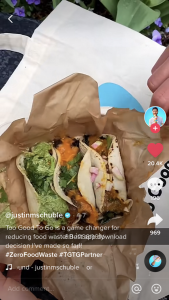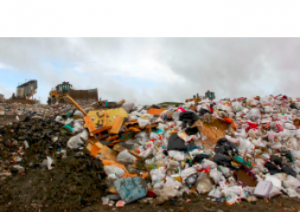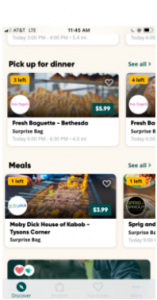A Solution for Items that are “Too Good to Go”
Mary Kate Ausbrook

With 530K followers, Justin Schuble has gained a large following on his Instagram account, dcfoodporn, which he uses to promote various restaurants around the Washington, D.C. area. His large audience has landed him various partnerships with different companies, one of which is called Too Good to Go. For the past year, I have seen him post pictures and videos of anything from colorful rice bowls with falafel, chickpeas, hummus, and pickled onions, to Nutella-filled buttery croissants. After seeing his posts and looking into Too Good to Go, I was shocked to find out that the elaborate meals he was posting about were examples of food from restaurants that would have gone to waste otherwise.
Food waste is a global problem that majorly threatens the environment as we continue to ignore the reality of its consequences. When massive amounts of food get dumped in landfills, it emits a greenhouse gas called methane, which largely contributes to climate change by trapping heat in our atmosphere. The World Wildlife Fund reports that by eliminating food waste, we could reduce our greenhouse gas emissions by 6-8% (World Wildlife Fund, 2021). Even further, oftentimes food that is thrown out is still in perfectly good condition to eat. The issue of food waste serves as a case of information asymmetry, as many of us are unaware of how dramatically the problem affects the environment, or we simply choose to ignore it altogether. Global food waste is a serious problem as supposedly “bad” food ends up in landfills and poses a threat to the environment, but the app Too Good to Go offers a potential solution by creating ways to help restaurants, bakeries, and grocery stores decrease their daily food waste.

Food waste is first problematic because we produce so much food, yet so much of it is ending up in landfills making it become a leading cause of climate change. According to Wasted! The Story of Food Waste 2017 documentary, ⅓ of food produced is wasted, with 90% of that food ending up in large landfills that emit greenhouse gases ⅓ of food produced is wasted, with 90% of that food ending up in large landfills that emit greenhouse gases (Chai and Kye, 2017). This statistic emphasizes the extent of our problem with food waste in the U.S. Another documentary called Just Eat It follows a couple who decide to live off of thrown-out food for a few months, while exploring the causes and effects of food waste. One clip from the documentary shows apples going down a conveyor belt and labeled as “bad” apples even though they look perfectly ripe. They discover too that grocery stores and restaurants reach a point where they cannot sell certain products because of the predetermined sell-by dates, even if they are in decent condition (Baldwin, 2014). This 30-40% of food waste amounts to about 20 pounds of food wasted per person each month. This waste is happening at all levels of food production and consumption: it happens in the supply chain when food is spoiled and unable to be sold, it happens in retail when food has physical damages or the food has been overbought, and it happens with consumers when people overbuy and have to throw out food they never ate (United Nations, 2021). In addition, food production requires incredible amounts of water and energy in order to grow and transport it globally, which are environmental impacts that we fail to acknowledge when we waste food (World Wildlife Fund, 2021). Ultimately, food waste is a major contributor to climate change and has multiple detrimental effects on the environment that must be recognized if we want to protect the planet.
According to the Environmental Protection Agency, landfills accounted for 15.1% of methane emissions in 2019. When food waste ends up in landfills, it first undergoes an aerobic decomposition phase in which oxygen is present and only a small amount of methane gets released into the atmosphere. Within a year, the food waste enters an anaerobic decomposition phase in which there is no longer any oxygen present. As a result, the food waste releases large amounts of methane as it is buried and in the absence of oxygen (Environmental Protection Agency, 2021). Furthermore, while CO2 is a large long-term contributor to climate change, the Environmental Defense Fund argues that reducing methane gas emissions is crucial for more immediate action in tackling climate change because methane is 80x more potent than CO2. As a result, taking action to reduce the amount of methane gas being released from food waste in landfills is an important step to take now to address major environmental concerns (Environmental Defense Fund, 2021).
This is where the app Too Good to Go steps in. Ranked as the #1 anti-food waste app, the company partners with restaurants, bakeries, grocery stores, and hotels in major cities to help them reduce food waste daily. These partners spanning from DC to San Francisco, with the addition of global partners too, struggle with food waste as a result of overfilled buffets, oversized portions, over-ordering or overstocking products, and more, but Too Good to Go gives them an opportunity to still sell these items. Too Good to Go encourages its partners to prepare “Surprise Bags” with leftover or defective foods that users of the app can then find nearby to them, reserve that bag, pick it up, and purchase it at a discounted price.

As a result, instead of these places tossing out the food they cannot sell, customers can be satisfied with decent food at a lower price, and the partners themselves can make an additional profit, while both sides of the transaction also participate in sustainability efforts. Items in these “Surprise Bags” might include a few slices of overcooked pizza, a sushi roll that was not sold that day, or various pastries from a bakery that might be on their way out (King, 2021). On its website, Too Good to Go reports that 35,231,069 meals from just restaurants have been saved, which translates to over 88,078 tons of CO2 saved. Overall, the website also states that it has helped save 102.5 million meals total all over the world, with 1200 partners, also known as “Waste Warriors,” across 17 different countries (Too Good to Go, 2021). Too Good to Go has clearly already helped work towards combating food waste, and it also has a lot of potential to continue growing its partnerships and customer base.

I have had Too Good to Go downloaded on my phone for a while now, but it was not until recently that I decided to try it out. When I opened the app, I set my location to show only restaurants within 5 miles of me, and then I had the option to pick from various restaurants, cafes, and bakeries including Moby Dick House of Kabob, Chaia Tacos, and the bakery Le Pain Quotidien. I picked Le Pain Quotidien because I did not need a full meal, and the description of the Surprise Bag noted that it could include “an assortment of baked goods and pastries or items like sandwiches, salads, soups, granola, etc. When you click on the restaurant you want, the app also lets you know a pick up time. I reserved my Surprise Bag from LPQ, paying a total of $4.99, and then went and picked it up during the pickup window time. Having paid through the app before, I entered LPQ, went up to the counter, and stated that I was there to pick up a Too Good to Go order. The order was ready and he handed me a bag with 5 bakery items in it: pain aux raisins, a mini chocolate almond banana muffin, a cheese croissant, a Belgian chocolate brownie, and a coconut macaroon.

Most of it tasted good and almost as it would if I ordered normally, with the exception of the macaroon being a tiny bit stale. However, the macaroon was still good considering it was an item that was the end of the day and would have otherwise been wasted. In addition, I looked at the items’ initial prices on the menu and found that if I had ordered these 5 items regularly from the menu, it would have amounted to $18.25, whereas I paid for almost perfectly good food for $4.99. I was very satisfied with how the app functioned, the quality of the food I received, and the discounted price.
At the same time, because Too Good to Go operates by using Surprise Bags, some of the items I got I simply did not like and would not have ordered normally. They happened to be items that my family also was not particularly fond of either, so we ended up tossing a couple of them out anyway. I expect that most of the time Too Good to Go satisfies its customers more so through the Surprise Bag meals instead of a few items from a cafe that might be hit or miss with personal preferences. I plan to continue to use the app and try out a meal from a restaurant like Moby Dick House of Kabob in the future instead, but I was still overall very impressed with the quality of the food I got in my bag.
However, Too Good to Go is not without criticism. As the founder of Club Sandwich Philly, a 501(c)(3) that delivers meals to people in need and offers harm reduction training, among other community outreach efforts throughout Philadelphia, Veronica Carden wrote an op-ed for the Philly Plain Dealer commenting on Too Good to Go’s shortcomings in Philadelphia.“Too Good to Go claims to be very accessible yet they advertise and operate solely online and in English. They have made a home in only Philadelphia’s wealthiest zip codes and offer no delivery option for Philadelphians facing mobility issues.” She argues that Too Good to Go only serves wealthier communities and does not address food insecurity in a place like Philadelphia where that is a reality for many residents (Carden, 2021). Carden, and many others, hold the opinion that these two issues should go hand in hand in finding a solution. The United Nations World Food Program USA reports that $1 trillion worth of food is lost or wasted, adding that this wasted food would be enough to feed 2 billion people, which is 2x the number of hungry people around the world (United Nations, 2021). With food insecurity as an evident problem in our world, how can we have so much overproduction and waste of food, yet also have millions of Americans going hungry at the same time?
A month after Carden posted her article in March of 2021, the Philadelphia Eater responded to it by interviewing Carden to hear her perspective further. Carden told the Philadelphia Eater “If people are going to come into Philly’s food ecosystem, they need to make it better, and if they don’t make it better, they really need to leave it alone… the people they’re targeting are not the most vulnerable populations in the city — the people who could really benefit from discounted food.” She further added that the food sold in the Surprise Bags with Too Good to Go would be better if they were donated or given away. Carden feels strongly that Too Good to Go is doing Philadelphia a disservice by being inaccessible for poorer populations in Philadelphia.
In the same article from the Philadelphia Eater, author Maddy Sweitzer-Lammé also interviewed Philadelphia restaurant owners who have partnered with Too Good to Go. One such restaurant owner interviewed was Judy Ni, owner of Baology in Center City which sells Taiwanese street food, and uses Too Good to Go a few times a week to sell leftovers. Ni discussed that she and her staff already do try to limit their food waste, but when they do have for example damaged or overcooked dumplings, Too Good to Go is very helpful. She added that a better alternative does not exist where someone in a mutual aid community would coordinate the logistics of picking up a couple of meals and delivering it to food-insecure people. Ni finally mentioned too that “The people who are buying the food bags aren’t food insecure in the traditional sense; they’re coming at it from a food waste perspective, and if they appreciate the savings as well, that’s great” (Sweitzer-Lammé, 2021). Ni offers an important perspective here as she makes the point that Too Good to Go’s main mission is to help reduce food waste. While perhaps the company could do more to address food insecurity as well, it is still fulfilling its goals of eliminating food waste around the world.
The lack of understanding we have about food waste and its effect on the environment, combined with the lack of initiative to seek out anti-food waste apps like Too Good to Go, reflect a major gap of knowledge within our society. While Too Good to Go has made a ton of progress in eliminating food waste by providing a solution to the foodservice industry, there still needs to be more education and understanding about the reality of the problem so that the public is incentivized to make a difference. For now, though, Too Good to Go is facilitating crucial change, with a lot of potential to grow and to continue fulfilling its goals of reducing food waste.
REFERENCES
Baldwin, G. (2014). Just Eat It. Canada.
Carden, V. (2021, March 4). Opinion: “too good to go,” has got to go. the for-profit app threatens the literal food chain. Philly Plain Dealer. Retrieved from https://phillyplaindealer.com/2021/03/04/opinion-too-good-to-go-has-got-to-go-the-for-profit-app-threatens-the-literal-food-chain/.
Chai, A. and Kye, N. (2017). Wasted! The Story of Food Waste. United States.
Environmental Protection Agency. (2021). Basic Information about Landfill Gas. EPA. Retrieved from https://www.epa.gov/lmop/basic-information-about-landfill-gas.
King, R. (2021, May 5). This app fighting food waste around the world is gaining ground in the U.S. Fortune. Retrieved from https://fortune.com/2021/05/05/too-good-to-go-food-waste-prevention-app/.
Methane: A crucial opportunity in the Climate Fight. Environmental Defense Fund. (2021). Retrieved from https://www.edf.org/climate/methane-crucial-opportunity-climate-fight.
Sweitzer-Lammé, M. (2021, April 12). Is too good to go actually good for Philly? Eater Philly. Retrieved from https://philly.eater.com/2021/4/12/22368600/too-good-to-go-philly-food-waste-mutual-aid.
Too Good to Go: The Movement. Too Good To Go. (2021). Retrieved from https://toogoodtogo.org/en/movement/businesses/restaurants.
United Nations. (2021, October 1). 8 facts about how food waste and global hunger are connected. World Food Program USA. Retrieved from https://www.wfpusa.org/articles/8-facts-to-know-about-food-waste-and-hunger/.
World Wildlife Fund. (2021). Fight climate change by preventing food waste. WWF. Retrieved from https://www.worldwildlife.org/stories/fight-climate-change-by-preventing-food-waste.
